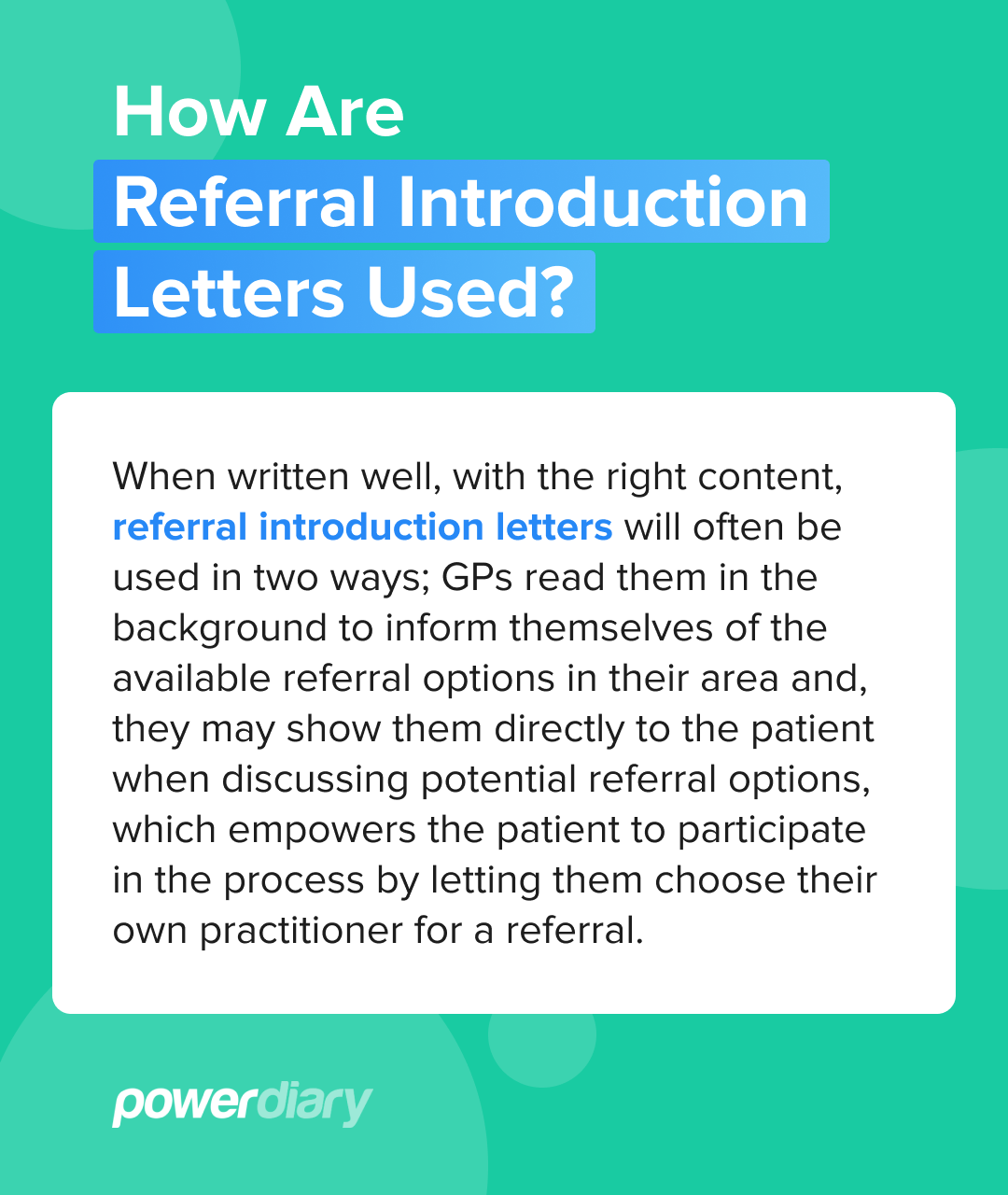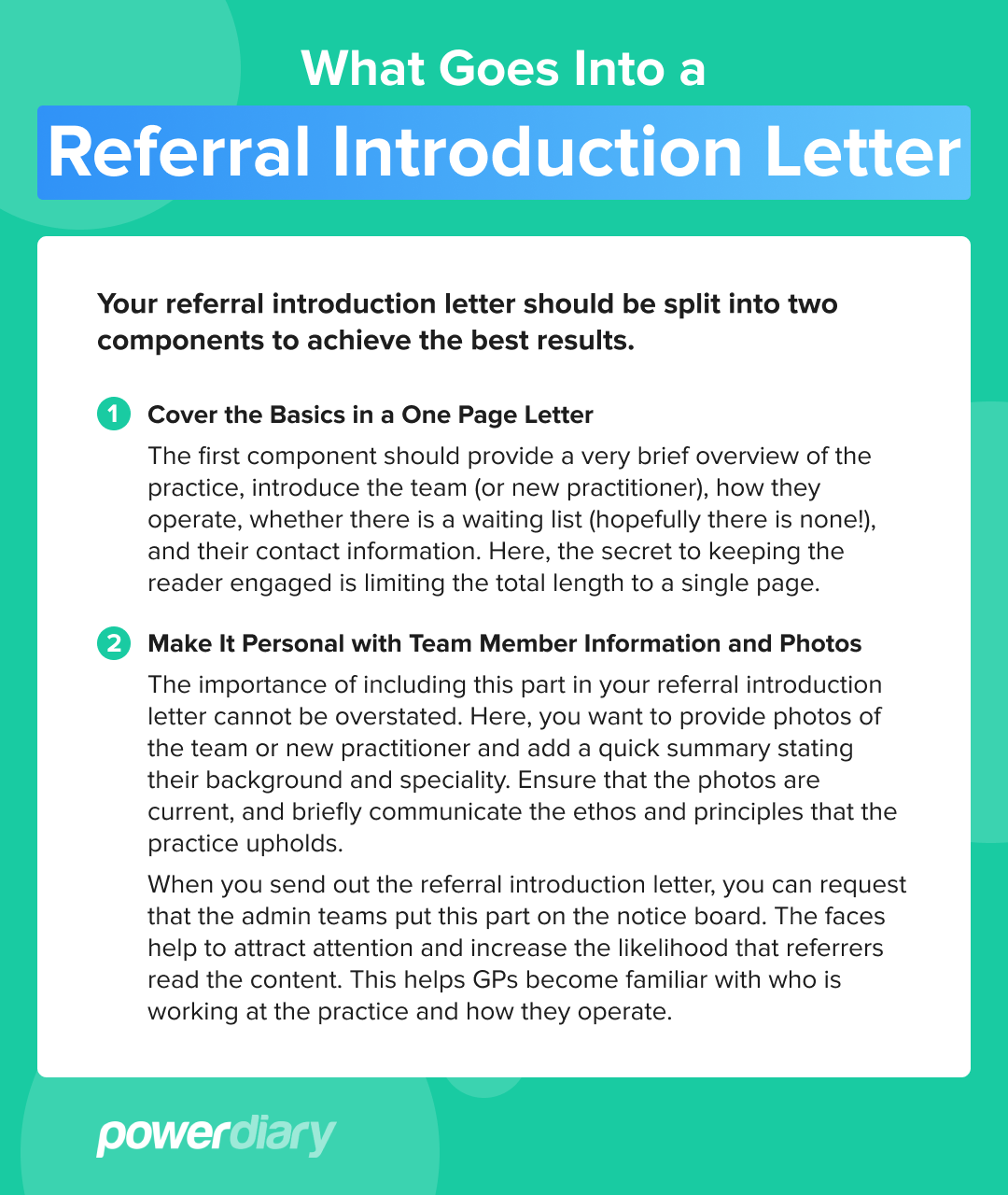Have you just opened a practice? Or has a new clinician recently joined your team?
If so, one of the best things you can do to make it a success is to write a great referral introduction letter. According to Damien Adler, co-founder of Power Diary and registered psychologist,
“Referral introduction letters are the most powerful, yet underused, marketing tools for health professionals. In fact, once we started sending these, they were so successful that we were able to stop all other advertisements, including Google Ads.”

What’s a Referral Introduction Letter?
A referral introduction letter introduces a healthcare professional (or a team of professionals) to potential referral sources such as General Practitioners (GPs), encouraging them to refer patients to you. These letters are typically sent to individual medical professionals within a practice and to their admin teams.
General Practitioners tend to refer patients to health practitioners they’re familiar with, so when writing a referral introduction letter, you should aim to increase the GPs familiarity with your practice, people and approach, whilst still keeping it to the point and professional.
How Are Referral Introduction Letters Used?
When written well, with the right content, referral introduction letters will often be used in two ways; GPs read them in the background to inform themselves of the available referral options in their area, and they may show them directly to the patient when discussing potential referral options, which empowers the patient to participate in the process by letting them choose their own practitioner for a referral.
This means that it’s crucial to distribute printed copies of your referral introduction letter in addition to emailing it as a PDF and having the same information on your practice website. GPs may even place referral letters under their clear plastic desk protectors and use them as a quick reference. Others may rather pull up the relevant page of your practice website and show it to a patient on their computer screen.
What Goes Into a Referral Introduction Letter?
Your referral introduction letter should be split into two components to achieve the best results.
Component 1: Cover the Basics in a One Page Letter
The first component should provide a very brief overview of the practice, introduce the team (or new practitioner), how they operate, whether there is a waiting list (hopefully there is none!), and their contact information. Here, the secret to keeping the reader engaged is limiting the total length to a single page.
Let’s take a look at the elements of a powerful referral introduction letter in more detail:
Initial Information
For ease of reference, it’s helpful to start a referral introduction letter with the date and your location so that practitioners can confirm they have current information and quickly see where you are.
Introduction
The introduction should state when the practice opened because it helps create familiarity and establish credibility. If the practice is expanding, share this and make mention of the new practitioner joining the team. You could also explain why they’re a good fit for the practice.
Waiting List
Hopefully, being a new practice, or having recently added a new team member, you don’t have a waitlist. If so, promote this in your introductory letter so GPs know their patients will not need to wait a long time to get the treatment they need. However, it is important to provide an inviting explanation for your practice’s availability. For instance, you could explain that the practice has grown recently, or is now offering extended trading hours. This prevents GPs from assuming that your high availability is due to low demand for your services.
(If you have a long waiting list, and are unable to provide services within a reasonable time, then it may be best to hold off sending an introductory letter until you are in a position to service the extra referrals the letter will generate.)
Finally, you can mention how the GP can refer patients to the practice overall or to a specific practitioner.
More About the Clinic
Here, you should provide a brief overview of the focus of the practice and can touch on the preferred treatment approaches of the practitioners. You could also list which conditions the practice treats or is well-known for treating.
State the days and times the practice is open and in which formats practitioners will provide services (for example, physical consultations and mobile services).
For Additional Information
This is the final section of Part 1, and it’s where you tell people how to contact you. Examples of details to give here are telephone numbers, email addresses, and website URLs.

Component 2: Make It Personal with Team Member Information and Photos
The importance of including this part in your referral introduction letter cannot be overstated. Here, you want to provide photos of the team or new practitioner and add a quick summary stating their background and speciality. Ensure that the photos are current and briefly communicate the ethos and principles that the practice upholds.
When you send out the introduction referral letter, you can request that the admin teams put this part on the notice board. The faces help to attract attention and increase the likelihood that referrers read the content. This helps GPs become familiar with who is working at the practice and how they operate.
Furthermore, having a photo and a basic description of a practitioner’s therapeutic approach increases the chances that clients will be well-matched with the clinician they are referred to.
Be sure to include similar information (with photos!) on your website. Damien recalls,
“One day, the team profile page of our website went down. We started getting calls from GPs asking where our page went. It turned out that GPs were pulling up the website and showing it to patients when making referrals, and patients were self-selecting the practitioner they felt they’d be most comfortable with.”
Finally, ensure you include photos and a description of your admin team also. These are the team members that will likely have the initial contact with the patient so it’s important that GPs and patients feel familiar with them too.

How to Make the Most of Your Referral Introduction Letter
You can make the most of your referral introduction letter by ensuring that it has a professional layout and by following up each time you receive a referral.
Give Your Referral Introduction Letter a Professional Layout
Creating a professional referral introduction letter doesn’t have to be complicated. Ensure that you use clear, concise language, that all information is easily identifiable, and use standard font size, style, and line spacing.
Follow up When You Receive Referrals
When you start getting referrals from the people you sent letters to, ensure you identify those referred clients and get back to the referrer thanking them for the referral along with relevant clinical feedback.
Initially, referrers may send you a few patients as a test. Then, if the patients return to the referrer with positive feedback, they’ll continue referring to you. You can link clients and referrers in Power Diary so you’ll have the referral data you need to see who is (and isn’t) referring to you.
See how to write a great referral feedback letter here (includes a downloadable template).
Over to You
We hope you’re suitably convinced that the referral introduction letter technique is one your practice needs to jump on! It’s an opportunity to generate enthusiasm about your business and connect or reconnect with other medical professionals to grow your practice. In fact, for many health practices, it’s probably one of the most effective ways to market and grow your clinic.
So, are you ready to sit down and create your own referral introduction letter?
We’ve made this easy by creating an example to use as a starting point. Download it and create a letter to suit your specific needs. Then, send it out, sit back, and smile as new patient referrals come in!

Damien Adler discusses his experience using referral introduction letters as a marketing tool for private practices. As well as being a co-founder of Power Diary, Damien is a registered psychologist and a current Director of Mind Life Clinic. He is passionate about empowering health practitioners to grow their clinics while minimising admin work. Damien is known publicly through his 13 years as a fortnightly guest on ABC Radio, as well as contributing to articles appearing in The Age, Women’s Weekly, Madison Magazine, Sunday Life, and Cosmopolitan Magazine. Damien has a background in health administration, previously holding senior positions in public health services.







